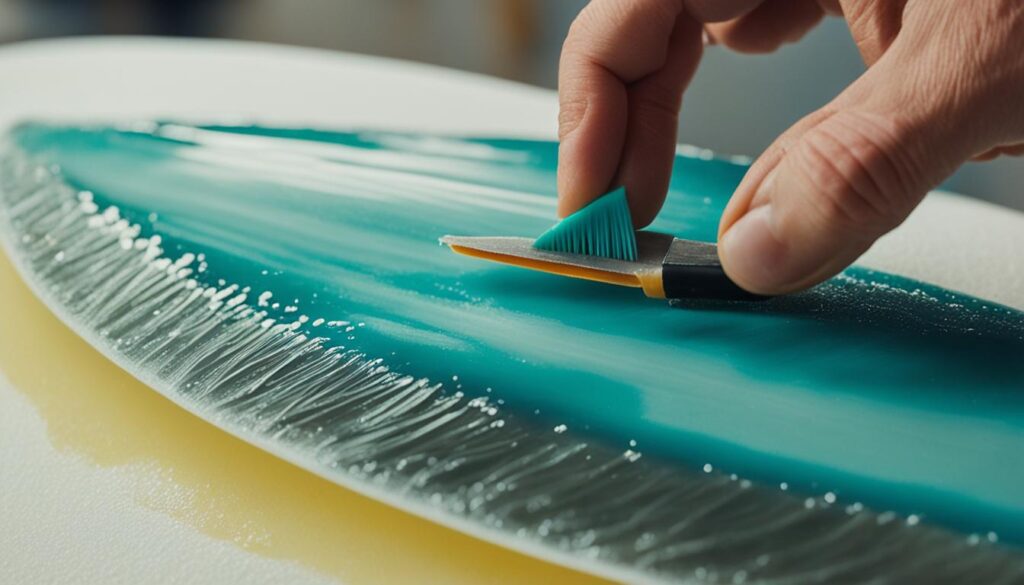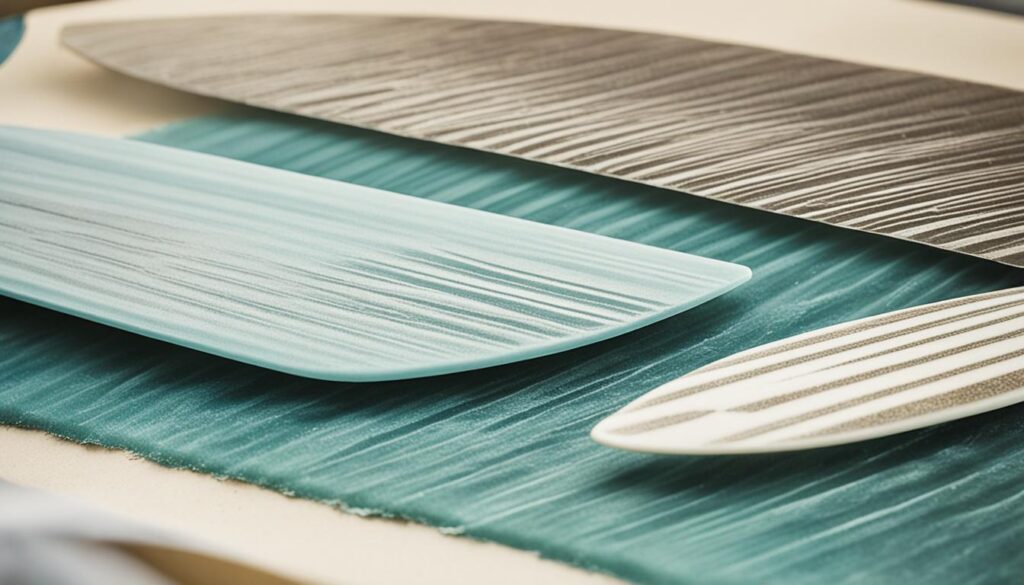Have you ever wondered how surfboard fins are made? What goes into the production of these essential components that provide stability and control in the water? In this article, we will delve into the manufacturing process, materials used, design considerations, and shaping techniques involved in crafting surfboard fins. Get ready to dive deep into the fascinating world of surfboard fin craftsmanship and gain a new appreciation for the art of wave riding.
Key Takeaways:
- Surfboard fins play a crucial role in providing stability, maneuverability, and control.
- The manufacturing process involves shaping the foam, gluing the wooden stringer, and glassing the surfboard.
- Commonly used materials for surfboard fins include EPS and XPS foam, as well as different types of fiberglass and resin.
- Surfboard fin design is a blend of art and science, with designers constantly experimenting to create the perfect template.
- Choosing the right fin system and installation method is essential for customization and optimal performance.
The Shaping Tools for Surfboard Fins
Shaping surfboard fins requires specific tools to carve and shape the foam. The essential tool for shaping is the Stanley Surfoam plane, a rasp-like tool that efficiently removes foam. Other important tools include various grits of sandpaper for refining the shape and achieving a smooth finish. These tools can be easily obtained at a local hardware store, making them accessible to aspiring surfboard fin makers.
The Stanley Surfoam plane is a versatile tool designed specifically for surfboard fin shaping. Its sharp blade and ergonomic handle allow for precise and controlled foam removal, enabling surfboard fin makers to shape and contour fins according to their desired specifications.
Sandpaper is another essential tool in the arsenal of surfboard fin makers. It is used for refining the shape, smoothing rough edges, and achieving the desired finish. Different grits of sandpaper, ranging from coarse to fine, are employed to progressively refine the shape and ensure a smooth surface.
Here is a list of the shaping tools commonly used in surfboard fin production:
| Tool | Description |
|---|---|
| Stanley Surfoam plane | A rasp-like tool for efficient foam removal |
| Sandpaper (various grits) | Used for refining shape and achieving a smooth finish |
With these tools at hand, anyone with a passion for surfboard fin making can bring their creative designs to life. Whether you are a seasoned pro or a beginner, having the right tools is crucial for crafting high-quality surfboard fins that enhance your surfing experience.
Different Types of Foam for Surfboard Fins
When it comes to crafting surfboard fins, choosing the right foam is essential for achieving optimal performance in the water. Two commonly used foam types for surfboard fins are EPS (expanded polystyrene) and XPS (extruded polystyrene). Let’s take a closer look at these foam options and their characteristics:
| Foam Type | Key Features |
|---|---|
| EPS Foam | Lightweight and water-absorbing |
| XPS Foam | Water-resistant but prone to delamination if damaged |
EPS foam is renowned for its lightweight properties, making it an excellent choice for surfboard fins. It absorbs water, allowing for optimal buoyancy and maneuverability. On the other hand, XPS foam offers water resistance, ensuring longevity and durability. However, it’s important to note that XPS foam can experience delamination if exposed to severe damage.
Both foam types have their advantages and considerations when it comes to surfboard fin production. Understanding the characteristics of EPS and XPS foam helps manufacturers and surfers choose the most suitable option for their specific needs.
Here’s an image showcasing various surfboard fins with different foam types:
The Role of Wooden Stringer in Surfboard Fins
The wooden stringer plays a vital role in the construction of surfboard fins. It provides strength and stability, contributing to the overall performance and durability of the surfboard.
Traditionally, surfboards were built with a wooden stringer running through the center of the board. The stringer adds rigidity and prevents the board from flexing too much, enhancing control and responsiveness in the water.
However, with advancements in epoxy construction techniques, some surfboard manufacturers have started producing boards without stringers. Epoxy construction offers its advantages, including improved strength-to-weight ratio and increased durability.
Whether to use a stringer or not is ultimately a personal preference. Surfers who prefer a more traditional feel and flex in their boards often opt for stringers. On the other hand, those seeking a lighter, stiffer board may choose to go without a stringer.
When designing a stringer, there are various factors to consider, such as the type of wood used, its thickness, and the placement within the board. Thin plywood is commonly used for making stringers due to its flexibility and strength.
Stringer designs can vary, with different templates available to shape them according to specific board dimensions and performance requirements. The shape and size of the stringer can influence the flex pattern and responsiveness of the board.
Overall, the decision to incorporate a wooden stringer in surfboard fins depends on individual preferences and the desired characteristics of the board. Whether it’s for added strength, flex, or a more traditional feel, the wooden stringer remains an important element in the craftsmanship of surfboard fins.
Gluing and Shaping the Surfboard Blank
Creating a surfboard fin begins with the meticulous process of gluing the wooden stringer between the block EPS foam. To ensure precision, a stringer template is traced onto the foam, serving as a guide during hot-wire cutting or other foam removal methods. This initial stage lays the foundation for shaping the surfboard blank, where attention to detail is paramount. The shaping process requires a meticulous approach to ensure everything is level, even, and aligned properly.
“Shaping the surfboard blank is like sculpting a work of art. It requires skill, precision, and a keen eye for detail.”
Shaping the surfboard blank involves carefully shaping the foam to achieve the desired design and performance characteristics. It’s important to consider factors such as the curvature, thickness, and overall geometry of the surfboard fin. By skillfully blending these elements, surfboard fin makers can create a fin that complements the surfer’s style and optimizes performance in the water.
To illustrate the process visually, here’s a step-by-step guide to gluing and shaping the surfboard blank:
- Prepare the wooden stringer by cutting it to the desired length and other specifications.
- Apply an adhesive, such as epoxy or resin, to one side of the stringer.
- Place the stringer onto the foam, aligning it according to the traced template.
- Apply pressure evenly to ensure a secure bond between the stringer and the foam.
- Allow the adhesive to cure according to the manufacturer’s instructions.
- Once the glue has cured, use a surfoam plane or similar tool to shape the rough surfboard blank.
- Refine the shape using different grits of sandpaper, smoothing out any imperfections.
- Regularly check the alignment and symmetry of the surfboard blank during the shaping process.
- Continue shaping until the surfboard blank matches the desired design and specifications.
| Key Steps | Key Considerations |
|---|---|
| 1. Prepare the wooden stringer | – Cut stringer to desired length and specifications. |
| 2. Apply adhesive to stringer | – Use epoxy or resin for a secure bond. |
| 3. Align and press stringer onto foam | – Use traced template for proper alignment. |
| 4. Allow adhesive to cure | – Follow manufacturer’s instructions for curing time. |
| 5. Shape the rough surfboard blank | – Use surfoam plane or similar tool. |
| 6. Refine shape with sandpaper | – Different grits for a smooth finish. |
| 7. Check alignment and symmetry | – Ensure levelness and evenness throughout. |
| 8. Continuously shape until desired design is achieved | – Pay attention to details and adjust accordingly. |
By following these steps and paying careful attention to the intricate process of gluing and shaping the surfboard blank, surfboard fin makers can lay the groundwork for creating high-performance fins that enhance the surfing experience.
Installing the Fin Setups
Surfboard fins play a crucial role in determining the performance and maneuverability of a surfboard. To achieve optimal performance, it’s essential to choose the right fin system and installation method. Let’s explore the various surfboard fin systems available and the installation methods associated with each:
Bahne Box
The Bahne box is a popular fin system that uses a removable fin setup. The box is inserted into a pre-cut slot on the surfboard, allowing for easy installation and removal of fins. This system provides flexibility in adjusting fin configurations to suit different wave conditions and riding styles. However, it’s important to ensure that the Bahne box is securely installed to prevent any fin movement during surfing.
FCS (Fin Control System)
The FCS fin system is widely recognized for its versatility and performance. FCS fins use a plug and fin system, with the fins inserted into compatible plugs on the surfboard. FCS offers a wide range of fins with various templates and materials, allowing for customization based on individual preferences. The installation method involves securing the fins firmly into the plugs, ensuring a snug fit for enhanced stability and control.
Futures Fins
Futures Fins have gained popularity among surfers worldwide due to their innovative design and performance advantages. The Futures system utilizes a fin box that integrates seamlessly with the surfboard. Installing Futures Fins involves inserting the fin base into the box and securing it with a set screw for added stability. This system offers quick and effortless fin changes, enabling surfers to adapt to changing conditions effortlessly.
Glass-On Fins
Glass-on fins, as the name suggests, are permanently glassed onto the surfboard during the manufacturing process or by a skilled board shaper. This installation method involves laminating the fins directly onto the board’s surface, providing a solid, integrated fin setup. Glass-ons offer enhanced rigidity and direct transfer of energy, resulting in a unique surfing feel. However, it’s important to note that glass-on fins are not as adjustable as removable fin systems.
| Fin System | Pros | Cons |
|---|---|---|
| Bahne Box | – Easy installation and removal of fins – Flexibility in adjusting fin configurations |
– Possibility of fin movement if not securely installed |
| FCS | – Versatile and performance-oriented – Wide range of customizable fins |
– Requires compatible FCS plugs on the surfboard |
| Futures Fins | – Innovative design and performance advantages – Quick and easy fin changes |
– Requires a surfboard with a Futures fin box |
| Glass-On Fins | – Solid and integrated fin setup – Enhanced rigidity and direct energy transfer |
– Not adjustable like removable fin systems |
By understanding the different surfboard fin systems and installation methods, surfers can make informed decisions to optimize their surfing experience. Whether it’s the versatility of removable fin setups or the unique feel of glass-on fins, each system offers its own advantages. Choose the fin system that aligns with your preferences and surfing style, ensuring optimal customization for an unforgettable ride.
Glassing and Finishing the Surfboard
Once the surfboard fin has been shaped and its structural integrity established, the next step in the manufacturing process is glassing and finishing. This crucial stage involves applying layers of fiberglass cloth and resin to the fin, resulting in enhanced strength and durability.
Glassing the surfboard fin involves meticulously layering fiberglass cloth over its surface. This cloth is made from fine strands of glass that provide the necessary reinforcement. The type and weight of fiberglass chosen depend on the desired strength and performance characteristics of the surfboard fin. Different combinations can be selected to achieve specific flex, torsion, and response properties.
Resin plays a vital role in both bonding the fiberglass layers and providing a protective coating. There are two commonly used types of resin in surfboard manufacturing: epoxy and polyester. Epoxy resin offers increased strength, lighter weight, and excellent adhesive properties. Polyester resin, on the other hand, is more cost-effective and boasts a slightly higher resistance to UV radiation.
During the glassing process, the resin is carefully applied to the fiberglass cloth, saturating it completely. This ensures secure adhesion and a uniformly strong structure. Once the resin is applied, excess material is squeezed out using squeegees or rollers, reducing weight and excess resin. Properly fine-tuning resin application requires experience and precision to achieve optimal strength-to-weight ratios.
After the glassing process, additional steps may be taken to refine and finish the surfboard fin. These typically include trimming any excess material, sanding the surface to achieve a smooth texture, and sealing the board to protect it from water damage and discoloration. The finishing process adds the final touches that contribute to the overall quality and aesthetics of the surfboard fin.
Ultimately, the glassing and finishing stage is vital to the performance, durability, and longevity of the surfboard fin. The careful selection of fiberglass types, resin types, and meticulous application techniques create a finely tuned and robust fin, ready to take on the waves.
Check out the comprehensive table below to compare the different types of fiberglass and resin commonly used in surfboard fin manufacturing:
| Fiberglass Type | Characteristic |
|---|---|
| E-glass | Moderate strength and flexibility |
| S-glass | High strength and stiffness |
| Carbon fiber | Extreme strength and rigidity |
| Resin Type | Characteristic |
|---|---|
| Epoxy | High strength, lightweight, excellent adhesive properties |
| Polyester | Cost-effective, moderate strength, good resistance to UV radiation |
By understanding the fiberglass and resin options available, as well as the glassing and finishing techniques, surfboard fin makers can create fins that are tailored to specific performance and aesthetic requirements.

The Art of Surfboard Fin Design
Surfboard fin design is much more than just an aesthetic choice – it plays a crucial role in the overall performance of a surfboard. Designers meticulously craft templates that not only enhance the board’s visual appeal but also optimize its maneuverability and control in the water.
Creating a surfboard fin design starts with the outline template, which serves as the foundation for the fin’s shape, size, and placement. Designers carefully consider these factors to ensure the fin’s optimal performance for different wave conditions and riding styles.
Experimentation plays a vital role in the evolution of surfboard fin design. Professionals and dedicated enthusiasts are constantly pushing the boundaries, testing out new shapes and configurations to find the perfect match for their surfing style. This continuous refinement and modification of designs allow surfboard fin makers to create boards that deliver the ultimate ride.
Whether it’s through subtle tweaks or radical innovations, surfboard fin designers are constantly exploring new possibilities, driven by their passion to enhance the surfing experience. By combining artistry and scientific principles, they strive to create surfboard fins that not only excel in performance but also reflect the individuality and creativity of the surfers who ride them.

